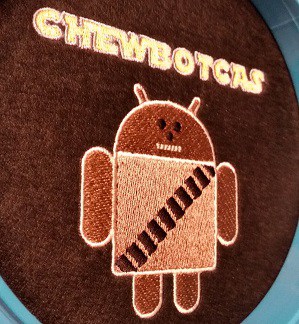With embroidered custom apparel, one of the biggest challenges can be thread color selection. That may seem like a nonsensical issue at first, but consider the two main issues:
- While there are thousands of Pantone colors, there are only hundreds of thread colors.
- The apparent color of thread is affected by the angle of view and the direction of the light source.
Even when there is not a direct thread color match for a given Pantone color, we can usually get pretty close.

In these situations, we usually try to give clients some different looks with multiple stitched proofs using different colors. We’re also happy to provide a client with a physical thread card (see nearby photo) showing all of the thread color possibilities so that the client can evaluate the the best color match. That’s the easy part!
The more interesting issue is how light reflects off of thread. The image below shows how our digitizer organized the threads in a design. The diagonal lines are the foundation underlay, stabilizing the fabric before the top layer. Note that the main body of the robot is segmented into alternating fields has horizontally oriented stitching while the head and limbs have vertically oriented rows of stitching. 
Those alternating fields seem inconsequential when you see a photo of the stitchout taken with a flash. Here, the light, a camera flash, is coming from close to the point of view, the camera lens. Now let’s look at a photo of that same design straight on without the flash. An overhead light is positioned directly above the stitched proof. Note the color hue has changed and you can just barely start to see the color shifting effect created by the direction of the thread orientation.
Now let’s look at a photo of that same design straight on without the flash. An overhead light is positioned directly above the stitched proof. Note the color hue has changed and you can just barely start to see the color shifting effect created by the direction of the thread orientation.
Now let’s look at a photo of that very same stitchout with the camera position moved about 45 degrees down. Yes, that is the exact same stitchout with the exact same thread color throughout the robot design. The stitchout has not moved and the light remains directly overhead.
Finally, here is the very same stitchout with the camera position inclined about 45 degrees to the left. Again, this is the same design with the same brown thread color throughout. 
Pretty stunning difference, is it not? Look back to the computer image of the digitized design to see why this is happening. The orientation of the brown thread has a directional effect on the reflection of light off of the thread.
So what to do with this information? Well, in this case for the Chewbotcas robotics team, this bonus feature to the embroidered design was received as “Awesome!” The color shifting effect was on theme with the group’s activity. But for a corporate client with a strong interest in protecting its brand image, wearing your own disco ball may not seem quite so awesome. In that situation, we would at least offer another stitched proof with the fill stitch fields reoriented into a parallel scheme.
We are big believers in offering options. Giving the customer a nice array of options from which to choose helps to educate the customer about the constraints faced by an embroidery shop and allows them to make a good decision.


